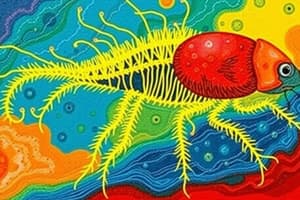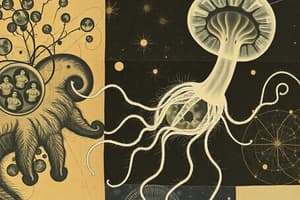Podcast
Questions and Answers
Is the paramecium a unicellular or multicellular organism?
Is the paramecium a unicellular or multicellular organism?
unicellular
To what Phylum and Kingdom do paramecium belong?
To what Phylum and Kingdom do paramecium belong?
Kingdom - Protista, Phylum - Ciliophora
Define heterotroph.
Define heterotroph.
Eating & consuming your food
What do paramecium eat?
What do paramecium eat?
How do all members of the Phylum Ciliophora move?
How do all members of the Phylum Ciliophora move?
What can't the paramecium change shape like the amoeba?
What can't the paramecium change shape like the amoeba?
What do the macronucleus and micronucleus do?
What do the macronucleus and micronucleus do?
Define conjugation.
Define conjugation.
What is the function of the contractile vacuole?
What is the function of the contractile vacuole?
What is the oral groove?
What is the oral groove?
Wastes exit the paramecium through what?
Wastes exit the paramecium through what?
What is the function of the trichocysts?
What is the function of the trichocysts?
Compare the endoplasm and the ectoplasm.
Compare the endoplasm and the ectoplasm.
Define avoidance behavior.
Define avoidance behavior.
Where do paramecium live?
Where do paramecium live?
Flashcards are hidden until you start studying
Study Notes
Paramecium Overview
- Paramecium is a unicellular organism, belonging to the Kingdom Protista and Phylum Ciliophora.
- It is characterized by its use of cilia for movement.
Nutrition and Feeding
- Paramecium are heterotrophs, obtaining food by consuming organic matter.
- They primarily feed on microorganisms and decaying organic matter like algal scum.
Structure and Movement
- Paramecium have a thick outer membrane called a pellicle that prevents shape alteration, unlike amoebas.
- All members of the Phylum Ciliophora utilize cilia for movement.
Reproductive Biology
- Paramecium possess two types of nuclei: the macronucleus, which manages respiration, protein synthesis, and digestion; and the micronucleus, which is involved in reproduction.
- Conjugation is a form of sexual reproduction where two paramecia exchange minimal genetic material by joining at the mouth pore.
Cellular Functions
- The contractile vacuole is essential for osmoregulation, helping to expel excess water from the cell.
- Food is swept into the oral groove, an inwardly pinched area lined with cilia, facilitating feeding.
Waste Management
- Waste products are expelled from the paramecium through an anal pore.
Defense Mechanisms
- Trichocysts are specialized organelles that enable paramecium to appear larger or ensnare potential predators.
Cytoplasmic Composition
- Ectoplasm, the outer layer, is thin, while endoplasm, the inner layer, is thicker, contributing to the cell's structure and function.
Behavioral Response
- Avoidance behavior is exhibited when paramecium move away from negative stimuli, aiding survival.
Habitat
- Paramecium thrive in quiet or stagnant ponds, where they find abundant food sources.
Studying That Suits You
Use AI to generate personalized quizzes and flashcards to suit your learning preferences.




